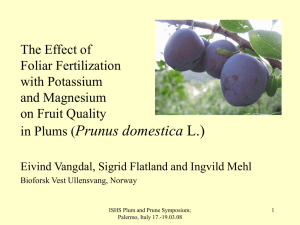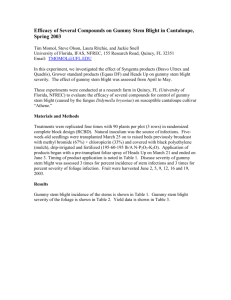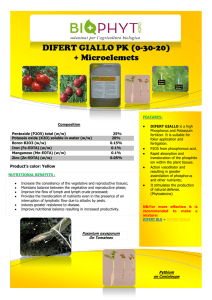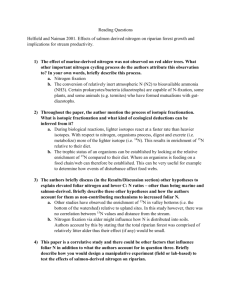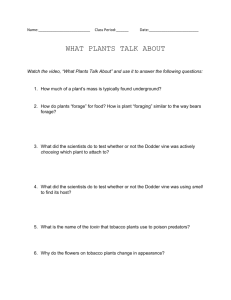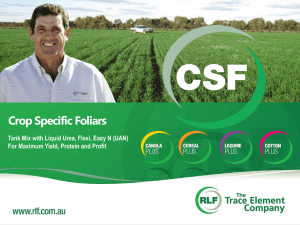Foliar Fertilization Efficacy
advertisement
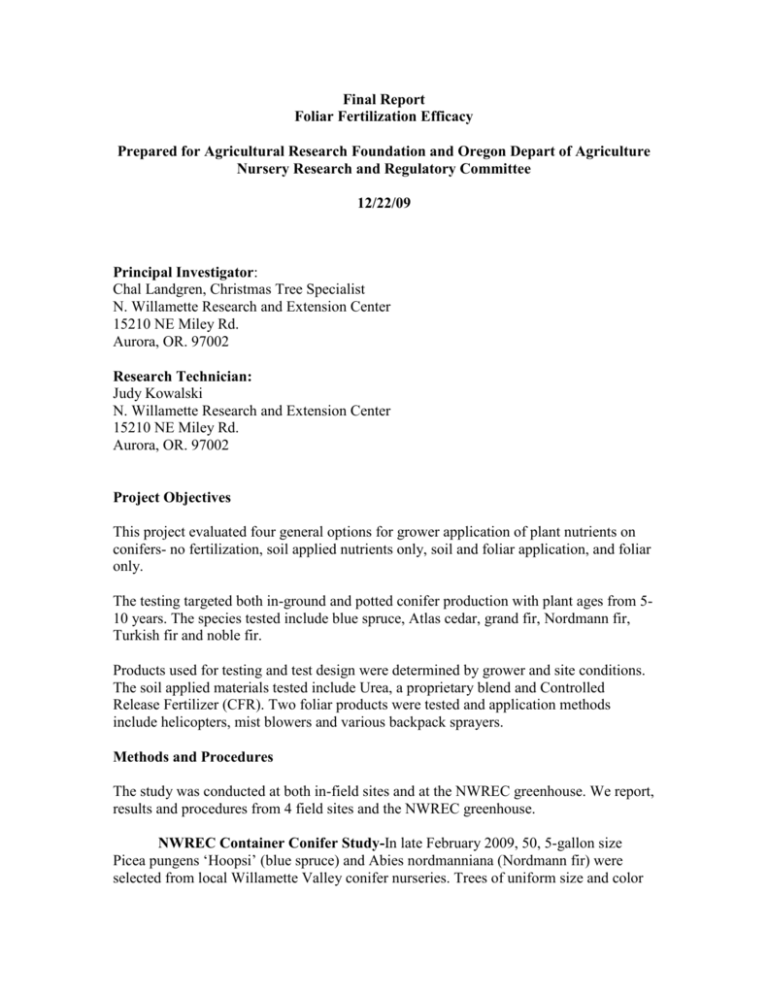
Final Report Foliar Fertilization Efficacy Prepared for Agricultural Research Foundation and Oregon Depart of Agriculture Nursery Research and Regulatory Committee 12/22/09 Principal Investigator: Chal Landgren, Christmas Tree Specialist N. Willamette Research and Extension Center 15210 NE Miley Rd. Aurora, OR. 97002 Research Technician: Judy Kowalski N. Willamette Research and Extension Center 15210 NE Miley Rd. Aurora, OR. 97002 Project Objectives This project evaluated four general options for grower application of plant nutrients on conifers- no fertilization, soil applied nutrients only, soil and foliar application, and foliar only. The testing targeted both in-ground and potted conifer production with plant ages from 510 years. The species tested include blue spruce, Atlas cedar, grand fir, Nordmann fir, Turkish fir and noble fir. Products used for testing and test design were determined by grower and site conditions. The soil applied materials tested include Urea, a proprietary blend and Controlled Release Fertilizer (CFR). Two foliar products were tested and application methods include helicopters, mist blowers and various backpack sprayers. Methods and Procedures The study was conducted at both in-field sites and at the NWREC greenhouse. We report, results and procedures from 4 field sites and the NWREC greenhouse. NWREC Container Conifer Study-In late February 2009, 50, 5-gallon size Picea pungens ‘Hoopsi’ (blue spruce) and Abies nordmanniana (Nordmann fir) were selected from local Willamette Valley conifer nurseries. Trees of uniform size and color were chosen and transported to the North Willamette Research and Extension Center for the containerized portion of the study. Both species of trees were estimated to be approximately five years of age. The firs were from a provenance level collection grown from #2 size Weyerhauser plugs, while the spruce was a grafted cultivar. On March 13th 2009, foliar samples were taken from both species and sent for analysis (see Table 3). On March 18th 2009, re-potting began on both species. Trees were removed from their original 5 gallon containers and excess media was removed by gentle shaking and then rinsing in a water bath. Once adequately rinsed, 48 each of the spruce and fir were potted into 7-gallon trade size sterilized containers. a custom blended potting mix consisting of 50% coarse Douglas fir bark, 30% fine Douglas fir bark, 20% screened pumice and 3#/yd3 of CaCO3 (Calcium Carbonate) was used for both species. After potting, plants were moved into a retractable roof structure and placed on a gravel/shade cloth surface. Individual drip irrigation spikes were placed in each pot. Trees were arranged into random blocks (CRD) and labeled for one of 5 fertilizer treatments to be applied at a later date. Treatment groups included either a foliar only fertilizer treatment, a controlled release fertilizer (CRF), or a combination of both. With one of the foliar only treatments, the media was covered with a thin plastic barrier to exclude any fertilizer contact with the media. An untreated control group, which received no fertilizer throughout the entire growing season, was also included. Each treatment had 8 repetitions. Please see table #1 for exact treatments and rates. On April 2nd 2009, CRF treatments, #’s 5 and 6, were applied to the surface of the media in each of the pots. The CRF was a 13 month formulation of an industry standard product, with an analysis of 18-5-9. The medium label rate was used and each amount was weighed out before application. All treated trees were hand watered after CRF application. On May 1st 2009, growth measurements were taken on both species. Each tree’s height, caliper and total weigh was measured. To collect total weight data, trees were not irrigated prior to weighing for a 24 hour period. Each tree was placed onto a portable scale and the weight, including the potting media and pot, was recorded. By May 12th 2009, the new growth on the Spruce had expanded enough to apply the foliar fertilizer treatments. Trees were arranged for spray treatments and products were applied as overhead spray treatments at 20 gallons of spray solution per acre. The spray solution was applied with the use of a CO2 powered backpack sprayer with a single head boom with flat fan spray nozzle. Treatments included three foliar sprays using Helena products Kayphol (0-5-32), CoBo (12-0-0) and PhosCalZn (4-15-0) (Helena mix) and one treatment using a Wilbur Ellis product with an analysis of 13-8-8 (W-E foliar). Trees were placed back into blocks and irrigated as usual. A second application of foliar fertilizer treatments was applied on June 9th 2009 to the same group of Spruce trees, following the same procedure. Almost two weeks later, on May 27th 2009, the new growth on the Fir trees was ready for the first application of foliar fertilizer treatments to be applied. Treatments were applied to the Fir trees following the same procedure as used with the Spruce trees. On June 22nd 2009, the second and final application of foliar fertilizers was applied to the Fir trees. On August 4th 2009, growth measurements were taken again on both species. Height, caliper and weight data was recorded as previously done in May. Both species were kept on a regular irrigation schedule throughout the growing season. Leaching fractions, electrical conductivity (EC) and pH tests were also done periodically during the study. Fairdale-Mira Monte Farm-Directly south of the North Willamette Research and Extension Center, at Fairdale Nursery, two different field planted conifer species were selected to receive two foliar fertilizer treatments. On March 13th 2009, ten blocks, consisting of ten repetitions each, of Cedrus atlantica 'Glauca' (Atlas Cedar) and Picea pungens ‘Hoopsii’ (Blue Spruce) were marked off for treatment. Heights of ten representative trees of each species were recorded and foliar samples were taken and sent for analysis. By May 18th 2009, the new growth on both species had expanded enough to apply the foliar fertilizer treatments. The same products that were used in the container study were also used in the field study; one treatment with the Helena products Kayphol (0-5-32), CoBo (12-0-0) and PhosCalZn (4-15-0) and one treatment using the Wilbur Ellis 13-8-8 product. Treatments were applied as overhead spray treatments at 10 gallons of spray solution per acre. The spray solution was applied with the use of a CO2 powered backpack sprayer with a single head boom with flat fan spray nozzle. Please refer to Table #2 for exact treatments and rates. On June 15th 2009, the second and final overhead spray treatment was applied to the same blocks of trees at Fairdale Nursery. On August 20th 2009, foliar samples were taken again and sent for analysis (results on table 4). Trees, from both the NWREC location and the Fairdale Nursery location, were periodically checked for signs of any phytotoxicity or any notable differences in color. Table 1. Treatments for NWREC trial Treatment # 1 Treatment id’s F1/pink F1/pink F1/pink 2 3 F2/yellow F3/green 4 C/white Type/Products Foliar/Helena-Kayphol Foliar/Helena-CoBo Foliar/HelenaPhosCalZn Foliar/Wilbur-Ellis Foliar-All Helena(F1) w/exclusion Untreated Control Analysis 0-5-32 12-0-0 4-15-0 Rate 16 oz/acre 32 oz/acre 32 oz/acre 13-8-8 As above 2 gal/acre As above 5 B1/blue CRF-Osmocote 6 B2/red CRF-Osmocote+ F1 18-5-9 (13 month) As above 182g/pot Analysis 0-5-32 12-0-0 4-15-0 Rate 16 oz/acre 32 oz/acre 32 oz/acre 13-8-8 2 gal/acre As above Table 2. Treatments for Mira Monte Field trial Treatment # 1 Treatment id’s F1/pink F1/pink F1/pink 2 F2/yellow Type/Products Foliar/Helena-Kayphol Foliar/Helena-CoBo Foliar/HelenaPhosCalZn Foliar/Wilbur-Ellis Heritage Plantation Christmas tree site- Two 5 yr. old noble fir field locations (field #8 and 27) were selected to test the W-E product as a foliar application. Field 8 had received an application of Urea in March (170 lb. of N/ac.), Field 27 received no Urea. The W-E foliar material was applied on 5/28 and 29 to blocks of trees using a motorized mist applicator at an application rate of 30 gpa with 2 g/ac. of the W-E material. Noble Mountain Christmas tree site- This location has a large number of company conducted trials of a wide variety of products in 10-20 ac. blocks installed with helicopters. Reported here is a small trial installed with backpack applicators using the Helena and W-E mixes at the rates listed in table 2 above. Here, six year- old noble fir were treated with the foliar products in replicated rows. Approx. one half of each row received an application of Urea (by helicopter) at a rate of 160 lb. N/ac. in March, 2009. Sager Christmas tree sites- Applications were made on 3 sites and with 3 species (grand fir, Turkish fir, noble fir). Both the W-E and Helena products were used at the rates noted in table 2. Fertilizer applications were made by hand applications in March using a proprietary blend containing N, P, K, Mg, Zn, S and B. Results With the notable exception of the NWREC greenhouse trial, there were no visual differences observed in color or growth at any of the field sites between any of the treatments. The summary below illustrates foliar nutrient levels at NWREC and Mira Monte. Table 3. March 13th Foliar Samples-NWREC and Mira Monte (pre-foliar application) species Site N (%) P (%) K (%) Ca (%) Mg (%) S (%) B (ppm) Picea Mira 2.07 .243 .41 .64 .11 .101 16.7 Monte Cedar Mira 1.98 .196 .58 .40 .17 .149 29.6 Monte Fir NWREC 1.43 .147 .49 .35 .148 .101 6.9 Picea NWREC 1.94 .271 .5 .6 Table 4. August 20th 2009 Foliar Samples-NWREC species Flagging treatment N P (%) K Color (%) (%) Picea Pink Helena 1.14 .176 .66 Picea Yellow WE 1.09 .191 .62 Picea Green Helena 1.25 .206 .66 w/exculsion Picea White Control 1.28 .221 .71 Picea Blue CRF 2.21 .253 .96 Picea Red CRF 2.07 .259 1.02 w/Helena Fir Pink Helena 1.19 .181 .77 Fir Yellow WE 1.14 .159 .64 Fir Green Helena 1.09 .168 .75 w/exculsion Fir White Control .98 .162 .69 Fir Blue CRF 1.71 .168 .84 Fir Red CRF 1.9 .18 .98 w/Helena .186 .111 42.7 Ca (%) .2 .14 .14 Mg (%) .103 .092 .095 S (%) B (ppm) .072 15.5 .07 13.5 .079 14.8 .12 .28 .34 .093 .121 .133 .082 .116 .136 13.3 17.6 15.7 .23 .16 .15 .127 .11 .104 .093 .074 .078 17.1 10 20.4 .15 .21 .25 .101 .133 .141 .075 .108 .139 8.7 7 24.6 Fig. 1 August 20th 2009, NWREC Nordmann Firs. Treatments-left to rightCRF(blue), Helena w/exclusion(green), Untreated Control(white). Table 5 . August 20th 2009 Foliar Samples-Mira Monte Farm species Flagging Treatment N P (%) K Ca (all had Urea Color (%) (%) (%) Mg (%) S (%) B (ppm) .076 .072 .076 .136 .126 .134 .101 .1 .11 .101 .101 .103 applic.) Picea Picea Picea Cedar Cedar Cedar Pink Yellow White Pink Yellow White Helena WE Urea only Helena WE Urea only 1.82 1.91 2.11 1.69 1.49 1.51 .267 .233 .28 .145 .163 .148 .71 .64 .7 .79 .81 .81 .35 .33 .32 .38 .38 .39 12.7 13.5 14.4 23.6 19.3 21.5 NWREC and Mira Monte Results- The results at NWREC are illustrated in Table 4. Briefly, the spruce (Picea), treatments all looked similar, and the foliar results suggest little movement of the foliar material into the plant. The CFR treatment provided a noticeable increase in foliar N. The Nordmann fir at NWREC was the one treatment showing visible foliar color differences (Fig. 1). In addition to these visual differences, Table 4 indicates that the CFR and CFR+ foliar contained ample N, and thus the dark green foliage. It, is not clear if the foliar product produced a statistical different increase in N, but it was modestly higher (1.7 vs.1.9). The Helena product did provide additional Boron (no B was contained in the CFR product) Results at Mira Monte (table 5) indicate little movement of foliar material into the plants. It is important to keep in mind that this site did receive a Urea fertilizer application by helicopter across all the treatments. Noble Mountain- There were no significant differences in foliar levels for any of the measured nutrients between individual foliar products. Table 6 below averages the foliar nutrients among split plots that received Urea and those that did not and suggests a slightly higher N level on those plots receiving Urea, compared to foliar alone. Table 6. Noble Mtn Results Avg- no Urea Avg- w/Urea N (%) 1.25 1.28 P (%) 0.11 0.10 K (%) 0.56 0.55 Ca (%) 0.35 0.35 Mg (%) 0.13 0.13 S (%) 0.11 0.11 B (ppm) 17.71 17.13 Heritage Plantation- Table 7 below lists the nutrient levels in Oct. 2009. Here no differences are noted between any treatment. Table 7. Heritage Plantation foliar results Treatment control- no foliar Wilbur-Ellis control- no foliar Wilbur-Ellis Site N (%) P (%) K (%) Ca (%) Mg (%) S (%) B (ppm) Field 8- Urea (170 lbs N) Field 8- Urea (170 lbs. N) 1.34 1.32 0.126 0.131 0.66 0.69 0.47 0.45 0.128 0.128 0.09 0.09 18.2 16.6 Field 27- No Urea Field 27- No Urea 1.41 1.36 0.133 0.151 0.74 0.75 0.43 0.47 0.137 0.146 0.093 0.095 16.2 19.4 Sager sites- At this location applications were made on 4 species of Christmas trees (grand, Nordmann, Turkish, noble). In looking at individual species no, clear trends were noted in the foliar nutrient levels. In looking at combined and averaged foliar trends there was slightly more N in the foliar treated trees compared to those without. Table 8. Sager sites foliar results No Foliar W-E Helena N (%) 1.58 1.66 1.63 P (%) 0.14 0.14 0.13 K (%) 1.03 1.10 1.07 Ca (%) 0.60 0.64 0.66 Mg (%) 0.14 0.14 0.14 S (%) 0.11 0.11 0.11 B (ppm) 29.83 32.03 35.25 Summary Each conifer species and site are potentially different with regard to nutrient needs and response. Blue spruce appears rather “immune” to foliar application based on observations at NWREC and Mira Monte, Nordmann fir (on the NWREC site) appeared to pick-up some of the foliar fertilizer. On other sites, no treatment (soil or foliar) appeared to move the foliar nutrient content levels. Three “take home” messages across these sites might be the following- Check the foliar levels prior to fertilization. Establishing the base levels and monitoring future needs could save time and money. On most sites, the soil-applied materials should be looked at as the primary N source. On Nordmann fir, foliar applications may provide supplemental nutrients. Each conifer species and each site will present different challenges and needs.
